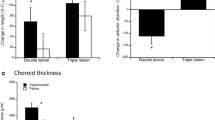Abstract
-
1.
If the eyes of young chickens are deprived of clear vision by translucent occluders, they develop considerable amounts of axial myopia within days. At the same time, the day time retinal dopamine levels drop by about 30%. Because the retinal dopamine levels of normally sighted chicks also differ diurnally and are low at night, we expected that the rate of axial eye growth might also differ during this time.
-
2.
Unexpectedly, eyes grew in length only during the day (about 0.13 mm/day) and even shrank during the night (about -0.04 mm/night, average net growth + 0.09 mm in 24 h).
-
3.
If the eyes were occluded, they grew both during the day and also at night (average net growth: + 0.16 mm in 24 h). Therefore, development of deprivation myopia was a result of the lack of growth inhibition at night rather than of excessive growth during the day when the actual deprivation occurred.
-
4.
Suppression of dopaminergic retinal pathways by intravitreal injections of the neurotoxin 6-hydroxy-dopamine (6-OHDA) also suppressed development of deprivation myopia and it restored the growth inhibition at night. With normal visual experience, the drug had no effect on axial eye growth and refractive state.
-
5.
Diurnal growth rhythms of the eyes disappeared under continuous light.
-
6.
Our results show that: (a) normal diurnal eye growth rhythms require a “normal” (12/12 h) light cycle and normal visual experience; with a degraded retinal image during the day, growth rates at night change so that they relate to retinal dopamine levels in the opposite way as with normal visual experience, (b) intact retinal dopaminergic pathways are necessary to mediate the deprivation-induced alterations in diurnal growth rhythms and myopia, (c) deprivation myopia is not simply a result of the lack of visual feedback control of eye growth during deprivation but rather of an active process related to abnormal diurnal dopamine rhythms.
Similar content being viewed by others
References
Bartmann ML, Weiss S, Schaeffel F, Zrenner E (1992) Diurnal variations in axial eye growth and their relation to retinal dopamine levels in chickens. Invest Ophthalmol Visual Sci 33 (Suppl):1052
Bock G, Widdows K (1990) Myopia and the control of eye growth. CIBA Foundation Symposium 155, Wiley, Chichester, UK, pp 1–256
Gottlieb MD, Nickla DL, Wallman J (1992) The effects of abnormal light/dark cycles in the development of form deprivation myopia. Invest Ophthalmol Visual Sci 33 (Suppl): 1052
Hodos W, Kuenzel WJ (1984) Retinal image degradation produces ocular enlargement in chicks. Invest Ophthalmol Visual Sci 25:652–659
Iuvone PM, Galli CL, Garison-Gund CK, Neff NH (1978) Light stimulates tyrosine hydroxylase activity and dopamine synthesis in retinal amacrine neurons. Science 202:901–902
Iuvone PM, Tigges M, Stone RA, Lambert S, Laties AM (1991) Effects of apomorphine, a dopamine receptor agonist, on ocular refraction and axial elongation in a primate model of myopia. Invest Ophthalmol Visual Sci 32:1674–1677
Jonsson G (1983) Chemical lesioning techniques: monoamine neurotoxins. In: Björklund A, Hökfelt T (eds) Handbook of chemical neuroanatomy, vol 1. Elsevier Science Publishers B.V., pp 463–497
Lauber JK (1987) Review: Light-induced avian glaucoma as an animal model for human primary glaucoma. J Ocular Pharmacol 3:77–100
Li T, Troilo D, Glasser A, Howland HC (1992a) Constant light produces severe corneal flattening and hyperopia in chickens. Invest Ophthalmol Visual Sci 33 (Suppl):2483
Li XX, Schaeffel F, Kohler K, Zrenner E (1992b) Dose-dependent effects of 6-hydroxy dopamine on deprivation myopia, electroretinograms and dopaminergic amacrine cells in the chicken. Visual Neurosci 9:483–492
Parkinson D, Rando RR (1983) Effects of light on dopamine metabolism in the chick retina. J Neurochem 40:39–46
Reme CE, Wirz-Justice A, Terman M (1991) The visual input stage of the mammalian circadian pacemaking system: I. Is there a clock in the mammalian eye? J Biol Rhythms 6:5–29
Rohrer B, Spira AW, Stell WK, Wagner HJ (1992) The site of action of dopamine in form-deprivation myopia. Invest Ophthalmol Visual Sci 33 (Suppl): 1052
Schaeffel F, Howland HC (1988) Visual optics in normal and ametropic chickens. Clin Visual Sci 3:83–98
Schaeffel F, Howland HC (1991) Properties of visual feedback loops controlling eye growth and refractive state in the chicken. Vision Res 31:717–734
Schaeffel F, Glasser A, Howland HC (1988) Accommodation, refractive error, and eye growth in chickens. Vision Res 28:639–657
Stone RA, Lin T, Iuvone PM, Laties AM (1989) Retinal dopamine and deprivation myopia. Proc Natl Acad Sci USA 86:704–706
Stone RA, Lin T, Iuvone PM, Laties AM (1990) Postnatal control of ocular growth: dopaminergic mechanisms. In: Bock G, Widdows K (eds) CIBA Foundation Symposium 155, “Myopia andthe control of eye growth”. Wiley, Chichester, UK, pp 45–63
Troilo D, Wallman J (1987) Visual deprivation causes myopia in chicks with optic nerve section. Curr Eye Res 6:993–999
Underwood HT, Siopes T, Barrett RK (1988) Does a biological clock reside in the eye of quail? J Biol Rhythms 3:323–331
Wallman J, Turkel J, Trachtman J (1978) Extreme myopia produced by modest changes in visual experience. Science 201:1249–1251
Wallman J, Xu C, Wildoset C, Krebs W, Gottlieb M, Marran L, Nickla D (1992) Moving the retina: a third mechanism of focusing the eye. Invest Ophthalmol Visual Sci 33 (Suppl): 1053
Author information
Authors and Affiliations
Rights and permissions
About this article
Cite this article
Weiss, S., Schaeffel, F. Diurnal growth rhythms in the chicken eye: relation to myopia development and retinal dopamine levels. J Comp Physiol A 172, 263–270 (1993). https://doi.org/10.1007/BF00216608
Accepted:
Issue Date:
DOI: https://doi.org/10.1007/BF00216608




